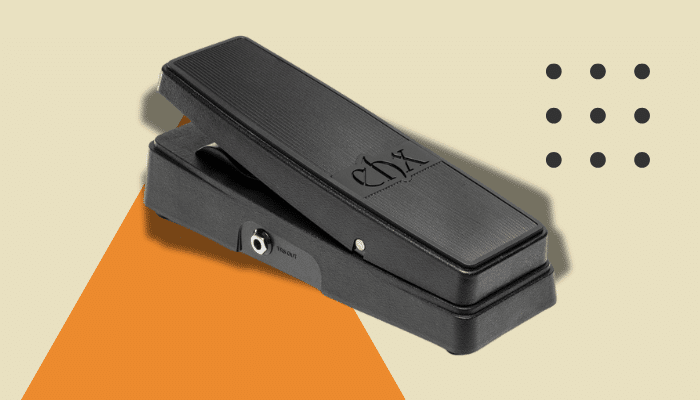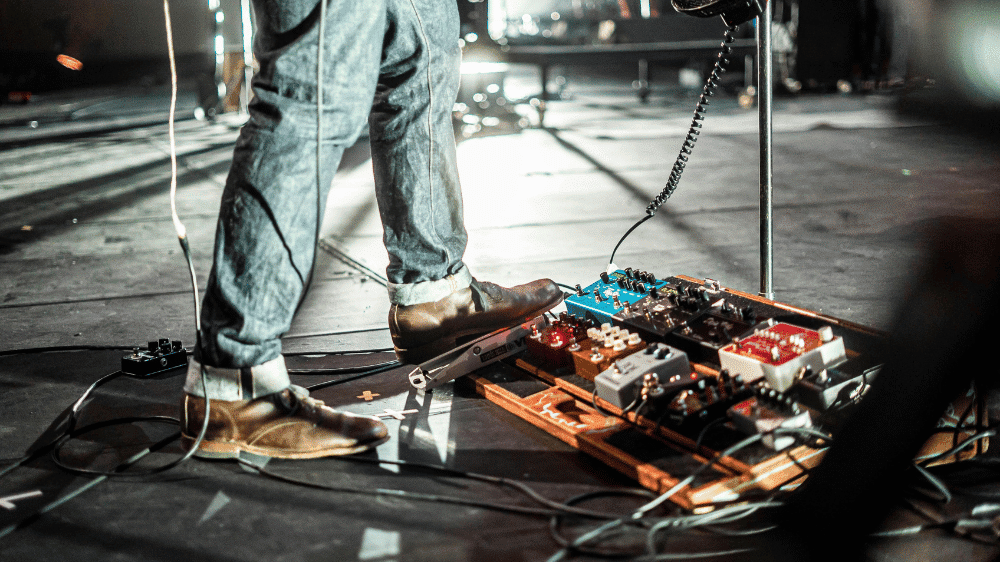The room went silent. I’d just plugged in my “thought-to-be-perfect” pedalboard for the first time at band rehearsal, played the first riff, and… nothing.
Well, not nothing exactly. But a lifeless, squashed mess that held no resemblance to the massive fuzz tone I’d been dreaming of.
Sound familiar?

I’d spent hours reading forums about compressor placement, following the “so-called-armchair-expert” advice to put compression first in my signal chain.
What nobody told me was that this conventional wisdom was destroying my fuzz pedal’s natural character.
Ughhh.
This disappointing, not to mention embarrassing, moment taught me more about the signal chain than years of watching YouTube or reading Reddit ever could.
The question of compressor before or after fuzz isn’t as simple as “before” or “after”. It depends on your musical goals, but understanding the science behind each approach will transform your tone.
In this article, I’ll share exactly what I learned from that humbling experience and give you the technical knowledge to make the right choice for your sound.
TL;DR – For Those in a Hurry
For most guitarists: Place your fuzz pedal BEFORE your compressor. This preserves the fuzz’s natural character while controlling output levels. Use compressor before fuzz only when you need studio-consistent, controlled tones.
Key Takeaways:
- Fuzz to Compressor = Character preservation (recommended)
- Compressor to Fuzz = Studio control and consistency
- Your guitar pedal order affects tone more than you think
- Professional players increasingly favor fuzz-first signal chains
Table of Contents
Why This Question Confuses So Many Guitar Players
Here’s the thing that tripped me up (and probably you, too): both compressors and fuzz pedals are often recommended for early placement in your signal chain.
The mixed messages are everywhere, and for good reason. Each approach fits different musical purposes.
Traditional wisdom places compressors first. But modern studio practices increasingly favor putting your fuzz before compression.
This choice massively affects your guitar’s dynamics, harmonic content, and the overall character, in ways that go far beyond simple volume control.
I’ve tried just about every possible configuration over the years, talked to countless guitarists, and studied professional signal chains. Here’s what I’ve discovered about deciding whether to put your compressor before or after fuzz.
The Science Behind Fuzz and Compressor Order
Understanding the technical side helps you make the right informed decisions about your signal chain. Here’s what actually happens inside your pedals when you change their order.
What Happens When You Put Compressor Before Fuzz?
This is where things get technical, but stick with me. It’s the key to everything.
Vintage fuzz pedals like the Dallas Arbiter Fuzz Face operate with deliberately low input impedance (5-8kΩ) compared to modern pedals’ standard 1MΩ. This isn’t a design flaw. It’s intentional. These circuits depend on direct interaction with your guitar’s pickups to function properly.
When you place a compressor first, you’re feeding the fuzz a processed, buffered signal that eliminates this crucial interaction with your pickups.
Modern fuzz pedals based on Big Muff circuits are a lot more forgiving, but the principle remains: fuzz circuits generate their characteristic harmonics and compression through natural saturation, not through external compression applied beforehand.
When considering compressor before or after fuzz placement, this impedance factor becomes a huge part of your decision.
Want to know why fuzz reacts differently to compression than other gain pedals? This guide explains how overdrive, distortion, and fuzz circuits work differently, which is crucial for understanding optimal signal chain placement.
How Does Fuzz Before Compressor Change Your Tone?
The frequency response differences between configurations are also super important.
Compressor before fuzz can change the frequency content before it reaches the fuzz circuit. This potentially reduces the treble content that vintage fuzz circuits need for proper operation.
Fuzz before compressor preserves the circuit’s natural frequency response while allowing you to control the wild volume swings that fuzz pedals are notorious for.
Compressor Before Fuzz
This pedal order gives you studio-friendly consistency, but it sacrifices the fuzz’s natural character. Understanding when to use a compressor before fuzz helps you make the right choice for your music.
Here’s what you get:
Benefits:
- Smoother, more predictable sustain
- Reduced noise floor
- More controlled dynamics
- Consistent volume levels
- Better for recording situations
The Trade-offs:
- Compressed signal eliminates volume spikes that can make fuzz overly saturated
- Significantly reduces volume knob sensitivity
- Can make fuzz sound lifeless or “neutered”
- Eliminates the classic ability to clean up fuzz with your guitar’s volume knob
How to Set Up a Compressor Before Fuzz
Start with basic and tame settings on both pedals. To do this:
- Set your compressor’s sustain/ratio to 10-11 o’clock
- Match the level to bypass volume
- Configure your fuzz with moderate gain (12-1 o’clock)
- Adjust fuzz volume for unity gain
This stops the compressor from over-processing the signal, but it maintains some of the fuzz’s essential character.

Fuzz Before Compressor
It seems most professional guitarists and studio engineers prefer this order. Let’s explore why this configuration has become the industry standard.
Why Do Studios Prefer Fuzz before Compressor?
Guitar tech Phil Taylor’s documented setups for David Gilmour, detailed in his book ‘The Black Strat: A History of David Gilmour’s Black Fender Stratocaster’ and various interviews, confirm this approach across multiple tours and recording sessions.
On top of this, studio engineers increasingly prefer the fuzz before compressor order for recording applications. As Origin Effects’ John Dines explains: “It’s usual studio practice to plug a guitar into a great-sounding amp, stick a mic in front of it and record that signal. It’s also very common practice to add compression to that signal after the event, either as you record or at some point in the mixing process.” [1]
The Tone Advantages
Advantages of Fuzz before Compressor:
- Preserves asymmetric clipping characteristics
- Allows the circuit to generate its full harmonic spectrum
- Creates prolonged, aggressive sustain with complex overtones
- Maintains volume knob cleanup behavior
- Keeps the “one-pedal, many tones” approach that made vintage fuzz legendary
This is why many players who struggle with the compressor before or after fuzz question ultimately choose the fuzz-first approach.
Setup for Fuzz before Compressor
When you do this, it’s best to use higher fuzz volume and lower compressor settings:
- This allows the fuzz to operate in its optimal range
- Set your fuzz gain higher (1-2 o’clock)
- Fuzz volume at 2-3 o’clock
- Use the compressor to tame output with sustain/ratio at 9-10 o’clock

Setup for Different Types of Fuzz
Different fuzz types likely require different setups and pedal orders. Here are some tips for some popular models:
Vintage Germanium Fuzz Pedals
These require fuzz before compressor placement to function properly. Germanium circuits demand high input impedance and direct pickup interaction. Any compression beforehand destroys their temperature-sensitive characteristics and touch-responsive behavior.
Big Muff vs Fuzz Face Circuits
Big Muff-style fuzzes generally work well with compressor before fuzz due to their already heavily compressed nature. However, many professional players prefer placing compression after to maintain the Big Muff’s characteristic midrange scoop and sustain.
Fuzz Face-style circuits almost always benefit from early placement followed by compression for output control.
Guitar Pickup Considerations
Single-coil pickups’ natural brightness and lower output work exceptionally well with both configurations, though fuzz before compressor preserves their clarity and definition better.
Humbucker pickups’ higher output can overload fuzz circuits, making compressor before fuzz beneficial for controlling input levels. However, many players prefer using the compressor after to manage the naturally higher output without affecting fuzz character.
Genre of Music Can Make a Difference
Blues and Classic Rock
Typically benefit from fuzz to compressor to preserve natural dynamics and volume knob cleanup. This maintains the expressive playing style these genres demand and is often the preferred answer to the compressor before or after fuzz debate for these styles.
Progressive Rock and Art Rock
Complex arrangements often require more predictable, controlled tones. Prog rock players often favor compressor before fuzz for consistent, controlled tones suitable for complex arrangements where predictability matters more than raw expression.
Stoner Rock and Doom Metal
Prefer fuzz before compressor to maintain maximum fuzz aggression while controlling output levels for mix compatibility.
Troubleshooting Common Issues
Excessive noise typically indicates power supply problems or impedance mismatches. Use isolated power supplies, high-quality shielded cables, and proper grounding.
If the compressor kills fuzz dynamics, reduce the compression ratio or switch to fuzz before compressor order.
For volume level problems, adjust the order based on whether you need input control (compressor first) or output control (compressor last).
The Both Sides Approach
Can’t decide? A small group of players actually use compression on both sides of their fuzz. This allows you to tame the dynamics going into the fuzz while still harnessing its unrestrained energy.
The before compression refines the fuzz’s boundaries, while the after compression molds it into perfectly controllable sustain. It’s complex, but it gives you maximum tonal control.

When to Skip Compression Entirely
Some players prefer a compressor-free setup for a more “in your face” fuzz tone with no loss of dynamics. If you find compressors restrict your playing too much, removing the natural transients and dynamics, going compressor-free allows your pick attack, note bending, and volume changes to come through the fuzz circuit unfiltered.
This maximizes expressiveness and sensitivity but means you lose the evened-out sustain and consistent note-to-note volume that compression provides.

The Bottom Line for Modern Players
The most successful approach combines understanding with a lot of experimentation. While traditional “textbook” placement (compressor first) remains great for specific applications, modern professional practice increasingly favors flexibility and context-dependent approaches.
Professional guitarists view pedal order as a creative tool rather than a rigid rule. Countless studio professionals adapt their approach based on the specific musical context and the sound they want to achieve.
Most of the time, starting with fuzz to compressor will give you the best balance of character preservation and practical control. This approach maintains the fuzz’s essential qualities while providing the output management that makes these powerful effects usable in band and recording contexts.
The key here is understanding your tone goals: choose compressor to fuzz for controlled, consistent results, or fuzz to compressor for preserved character with output control. The compressor before or after fuzz decision ultimately comes down to whether you prioritize control or character.
Put It Into Action
Now you’re armed with the knowledge to make an informed decision. Try both configurations with your specific pedals and musical style. Make notes about what works and what doesn’t. Remember that it’s not set in stone. You can change your approach for different songs or situations.
The most important factor isn’t following rules but understanding how each setup affects your guitar’s tone and choosing the method that you like best.
That embarrassing moment at band practice taught me that textbook knowledge means nothing if it doesn’t serve the music. Your ears are the final judge.














